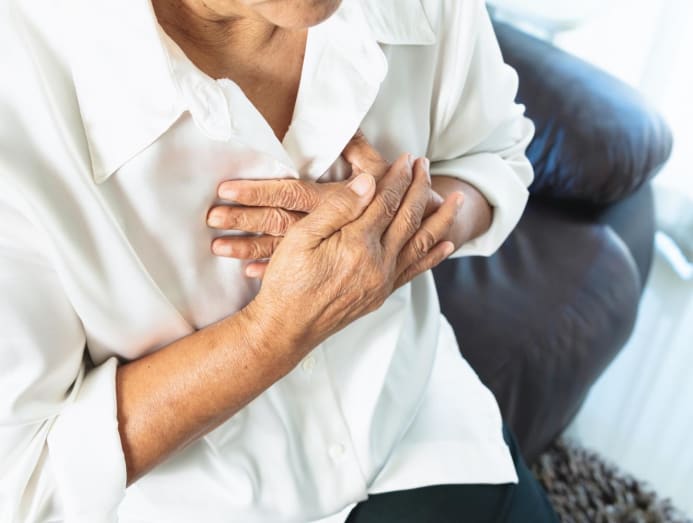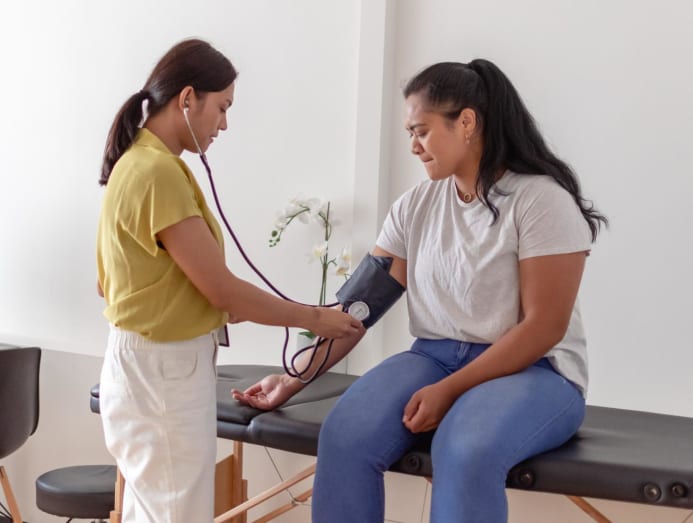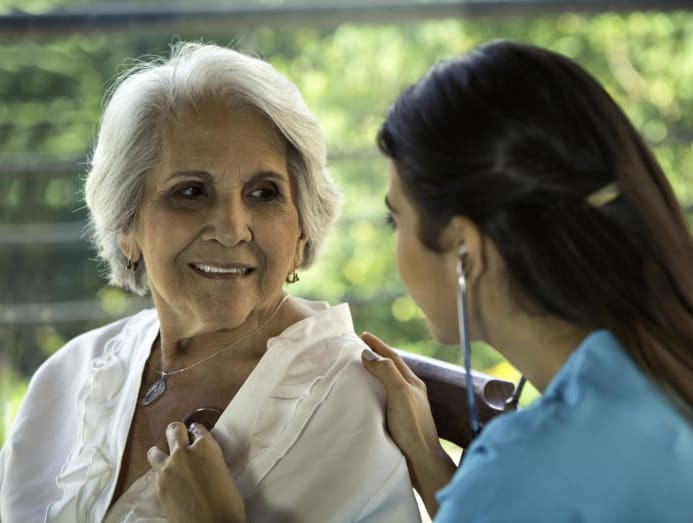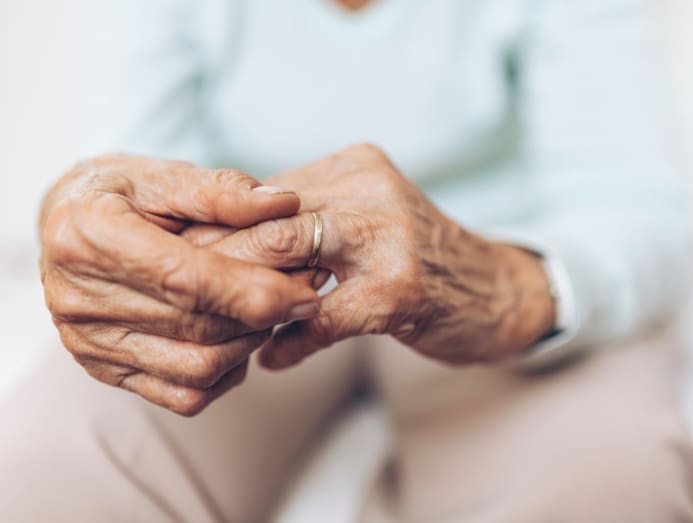Heart disease is deadlier in women: Everything you need to know about your heart health
A woman’s heart has its own workings, problems and ageing issues. CNA Women speaks with doctors to understand more about what makes it tick, literally.

An ever-growing body of research and improving medical science have provided us with a clearer picture of the female heart, everything from its structure, to the problems it’s prone to and what makes it tick. (Photo: iStock/Pongtep Chithan)
You know all those cliches about a woman’s heart being impossible to know and how everyone is clueless about what goes on in there? Time to ditch them.
Because in truth, an ever-growing body of research and improving medical science has provided us with a clearer picture of the female heart – everything from its structure to the problems it’s prone to and what makes it tick.
We now know, for instance, that a man and a woman’s heart have different mass, cavity size and wall thickness. In addition, a female heart tends to pump out a higher percentage of blood with each heartbeat, has a higher resting pulse and different rhythmic patterns.
And we also know that women’s heart health is something we really ought to pay more attention to.
According to information on the SingHealth website, cardiovascular disease (heart disease and stroke) is the number one killer among Singapore women, with one in three dying of it – a figure higher than breast cancer.
Studies also show heart disease to be deadlier in women because it often goes undiagnosed or under-treated.
Dr Edgar Tay, a cardiologist from Asian Heart & Vascular Centre, said: “Early studies suggested that most structures in male and female hearts were similar. But we now know that the female heart is not just ‘a smaller version of the male heart’.”
Related:
DIFFERENCES IN HIS AND HER HEARTS
Assistant Professor Angela Koh, a senior consultant at the National Heart Centre Singapore’s Department of Cardiology, said starting from adulthood, the size of the female heart is about one-quarter smaller than the male heart.
“But despite being smaller-sized, the female heart is richer in cardiac muscle cells than the male heart. Women’s hearts tend to have higher pumping strength and larger contractility – which is the force of contraction – than men’s,” she said.
Women also have faster heart rates. “An adult woman’s heart pumps at about 78 to 82 beats per minute, while a man’s heart is slower at 70 to 72 beats. This is likely because the left ventricle chamber of a woman’s heart is smaller, so more beats are needed to generate the same amount of cardiac output. Also, the heart’s natural pacemaker works at an increased rate in women,” said Dr Tay.

This difference in heart rate has a knock-on effect on how men and women react to and experience stress.
“Stress causes women’s heart rate to rise and more blood to be pumped out of the heart with each pumping cycle. They are more likely to experience heart palpitations, compared to men. When men are stressed, they experience more constriction of blood vessels, which lead to rises in blood pressure,” explained Assistant Prof Koh.
WHAT HAPPENS TO A WOMAN’S HEART WITH AGE
If you think that ageing means everyone eventually ends up with similar health problems – not exactly. At least not where the heart is concerned.
Cardiologist Dr Chan Wan Xian, also from Asian Heart & Vascular Centre, cited a study in which MRI scans were taken of nearly 3,000 older adults aged 54 to 94 with no pre-existing heart disease, and then analysed. The results showed that women experience a greater drop-off in heart muscle size and performance than men.
“The weight of the heart’s main pumping chamber increased by an average of 8g in men but decreased by 1.6g in women over a period of 10 years,” she said.
“And even though the heart’s filling capacity – the amount of blood the left ventricle can hold between heartbeats – declined in both sexes, it fell more precipitously in women, by about 13ml compared with just under 10ml in men.”

With menopause, women also lose a kind of natural protection against heart disease. “The levels of oestrogen, the female hormone produced by the ovaries, falls dramatically after menopause,” said Assistant Prof Koh.
Elaborating on oestrogen’s heart benefits, Dr Chan said: “Oestrogen relaxes blood vessels, indirectly improving blood flow. This results in an overall lower blood pressure in women than in men. Furthermore, oestrogen has the ability to generate new blood vessels and reduces the thickening or scarring of tissue in the heart’s muscles and vessels.”
Unfortunately, though, simply giving women an oestrogen top-up doesn’t help.
“Early studies where researchers tried to restore oestrogen levels have not been convincingly successful. Ageing itself seems to diminish the ability of oestrogen replacement to protect the heart, hence the rise in heart disease risks among women when they get older,” Assistant Prof Koh explained.
HEART PROBLEMS IN WOMEN
According to the Singapore Heart Foundation, oestrogen is the reason women generally have higher levels of good cholesterol and lower blood pressure than men. Hence, when menopause sets in and oestrogen level goes down, bad cholesterol level goes up. And with it, plaque build-up in the arteries, and a rise in blood pressure.

But although high blood pressure (or hypertension) is a common problem that affects nearly one-third of Singapore women aged 18 to 74 – according to statistics from the National Population Health Survey 2020 – there is another disease that women really need to be wary of.
Known as heart failure with preserved ejection fraction (HFpEF), Dr Chan said it affects twice as many women as it does men – and it’s increasing in prevalence.
“This type of heart failure occurs when the main pumping chamber of the heart is stiff and unable to relax normally between each heartbeat, even though it can contract and pump in a relatively regular way,” she explained. “This affects the amount of blood the heart can pump to the rest of the body.”
Dr Chan added that globally, HFpEF accounts for half of heart failure patients and is associated with high hospitalisation and mortality rates.
Dr Chan also drew attention to a highly common heart valve disease affecting women – aortic stenosis. Read: The stiffening and narrowing of the heart’s aortic valve.
“This valve is the first ‘door’ that must open to allow blood to be pumped out of the heart. But with age, there is wear and tear, and calcium deposition. The valve becomes stiff and blood flow is impeded.
“When this happens, the heart must pump harder, leading to thickening of the heart muscle and, eventually, heart failure. Severe untreated aortic stenosis can lead to premature death,” she said.
Assistant Prof Koh pointed out that older women may also suffer from heart rhythm conditions, usually in the form of irregular or ‘chaotic’ heartbeats and disorders that affect the heart’s natural pacemaker.
RISK FACTORS TO WATCH FOR
High blood cholesterol, hypertension, lack of exercise and obesity are all well-known risk factors that increase a woman’s odds of developing heart disease. So are diabetes and smoking, which have a bigger impact on women than men.

According to the Singapore Heart Foundation, women with diabetes have a higher risk of heart disease and other complications compared to men with diabetes, while female smokers have a 25 per cent higher risk of developing heart disease compared to male smokers.
“Risk factors also vary between older men and women. For example, obesity, hypertension and diabetes are highly prevalent in women with heart failure. For men, the underlying cause of heart failure tends to be coronary artery disease or when there is a restriction of blood flow and oxygen,” said Assistant Prof Koh.
Cardiovascular disease is often difficult to diagnose because the symptoms can be subtle.
In younger to middle-aged women, reproductive history affects their risk of developing future heart disease.
“During pregnancy, the development of gestational hypertension and diabetes are strong predictors of future heart disease. Women who have these conditions during pregnancy should have greater awareness about their risk of heart disease and adopt heart-healthy lifestyle habits early,” she said.
TAKING CARE OF YOUR HEART
Given that the female heart has its own traits and doesn’t function entirely like men’s, it’s important to understand the differences so you can spot signs of trouble and manage your heart health.

Here are a few points to keep in mind.
HEART ATTACK SYMPTOMS MAY DIFFER IN WOMEN
A 2017 article by Harvard Medical School reported that the symptoms of heart disease often show up differently in a woman, and she’s much more likely than a man to die within a year of having a heart attack.
Assistant Prof Koh said: “Cardiovascular disease is often difficult to diagnose because the symptoms can be subtle. The result is that women may delay going to the doctor, discovering their heart disease at a later stage or when it’s too late to seek effective treatment.
“Typically, men show symptoms of chest pain when having a heart attack. Women may experience chest pain as well, but they are more likely than men to also report atypical symptoms such as nausea, vomiting, sweating and pain at the neck, jaw, throat, abdomen or back,” she said.
The SingHealth website also lists other atypical heart attack symptoms a woman may experience: Feeling faint or dizzy, shortness of breath, fatigue, coughing and heart ‘flutters’.
BE AWARE OF HEART CONDITIONS THAT MAY MIMIC A HEART ATTACK
While men develop plaque build-up in the largest arteries that supply blood to the heart, Assistant Prof Koh said women are more likely to do so in the heart’s smallest blood vessels. When these small vessels constrict, they may cause chest pain similar to a heart attack.
Another example is a condition known as broken-heart syndrome.
“Typically occurring after emotionally stressful events, this mimics a heart attack in its symptoms and electrocardiogram patterns,” she said.

According to information from Harvard Medical School, over 90 per cent of reported cases are in women from ages 58 to 75, and up to 5 per cent of women suspected of having a heart attack actually have broken-heart syndrome.
Unlike heart attacks, however, most people recover from this disorder with no long-term heart damage.
LIFESTYLE MATTERS – A LOT
Adopting a heart-healthy lifestyle and habits can make a big difference in preventing and lowering your risk of cardiovascular disease.

Dr Tay recommended eating in moderation and maintaining a heart-healthy diet that’s high in fruits, vegetables, whole grains and fish.
“Have a regular exercise routine which you enjoy, or daily physical activity of moderate intensity lasting at least 30 minutes. Keep your body mass index less than 24.9 and your waist circumference under 35 inches (88.9cm). Also, stop smoking,” he advised.
Stress management is another important aspect that is frequently overlooked.
“If not managed properly, mental stress will affect the body’s metabolism of glucose and lipids, and have an impact on blood pressure, indirectly increasing the risks of cardiovascular disease,” he said.
GET REGULAR HEALTH CHECKS AND TAILORED CARE
A simple check is to have your family physician listen to your heart, said Dr Tay.
“Problems like aortic stenosis can generate a murmur which is easily detected by listening through the stethoscope,” he pointed out.
Assistant Prof Koh added it would be helpful for women to consult their doctor about their individual risk for heart disease.
“Discuss the risks and benefits of primary preventive measures that are customised towards your risk profile,” she said. “Although women generally experience coronary heart disease later in life than men, they tend to have worse outcomes, resulting in higher mortality and poorer quality of life.”
“Women should not wait till they are in their 40s before they make their heart health a priority. Prevention should start as early as possible,” Dr Tay advised.
CNA Women is a section on CNA Lifestyle that seeks to inform, empower and inspire the modern woman. If you have women-related news, issues and ideas to share with us, email CNAWomen [at] mediacorp.com.sg.







